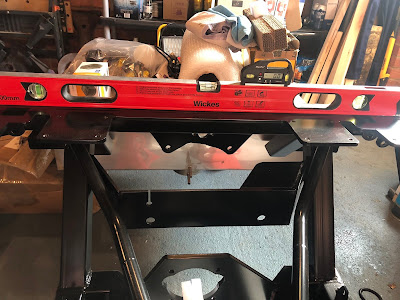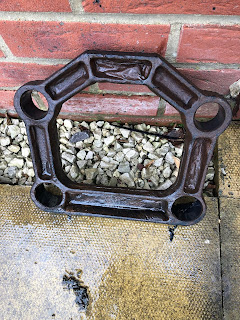Technical bit - the caster angle (as opposed to the camber angle) is the angular displacement of the steering axis from the vertical, the purpose of which is to provide a degrees of self-centreing for the steering.
Before checking the caster angles, the first step is to level up the chassis and the wishbones.
My garage floor is far from flat, level or even, so this apparently simple exercise took a fair amount of time.
The wishbones need to be horizontal for this step. Expecting to to have to do some redistribution of washers I did not fully tighten the wishbone bolts. This meant that I needed to support the wishbones on a another couple of axle stands.
Then I checked the chassis was level side to side, by placing a spirit level across the chassis rails at the front.
 |
| Wishbones supported - checking level across chassis |
My chassis is supported on axle stands with some off-cuts of carpet between the axle stand and the chassis to protect the powder coat. To get chassis level I jacked up the chassis and placed additional strips of carpet and / or thick corrugated cardboard on the axle stand to get everything levelled up.
I then placed a level on the top of the wishbones (you can just see the smaller level on the left hand wishbone in the photo above) and levelled the chassis front to back in a similar manner (whilst trying to maintain the level side to side...)
With that all sorted I carried out a final check on the level of the rear crossmember. I didn't need a spirit level to see that this was far from level - in fact it was about 10mm off across the whole length!!
I couldn't believe that the AK chassis would not be level - so I double checked all the levels again (with both my large and small spirit levels) and deduced that one of my spirit levels (if not both) were not reading accurately.
My iPhone is equipped with a measuring and level app; I have tried the measuring app and found it to be bobbins and didn't expect the level app to be any better (and besides it reads in whole angles only). So I downloaded the Angle Pro app which does give a reading to a 1/10th of a degree.
In order to check the Angle Pro app was working I also decided to buy a digital level from Amazon (ignoring my previous warning to check that what you are buying is the same as the picture - I received the world's smallest digital level by next day delivery....)
Then using a combination of spirit levels, iPhone Apps and the world's smallest digital level, I started the process all over again.
 |
| Level Front Crossmember - CHECK! |
 |
| Level Rear Crossmember - CHECK! |
 |
| Wishbone Horizontal - CHECK!! (it was also level front to back) |
Time to check the caster angles.
AK recommend a caster angle of between 6 and 8 degrees (with the aim that both sides are the same!). AK provide a paper gauge for this purpose; although the print quality is not great and it does rely on ensuring that a) the edge is actually parallel to the zero line on the gauge and b) the plumb line is fixed exactly at the intersection line of all the angle marks.
 |
| AK Caster Gauge in action (Photo courtesy of AK Sportscars) |
I wasn't convinced that this was going to give a particularly accurate result so I decided to use digital methods!
The caster angle is measured by butting the gauge / level up against the two M6 screws previously installed into each upright. The angle is then adjusted by redistributing the various washers on the upper and lower wishbones between the front and rear to alter the inclination of the upright.
The initial AK recommendations for distribution of the various washers proved pretty close in my case and I only had to move two washers from the front of the off-side upper wishbone to the rear to get readings on both sides of 6.7 degrees.
 |
| 6.7 Degrees on off-side upright... |
 |
| ...and 6.7 degrees on the near-side upright. Result! |
Now I can get on with the final assembly of the front wishbones and install front shocks.











































